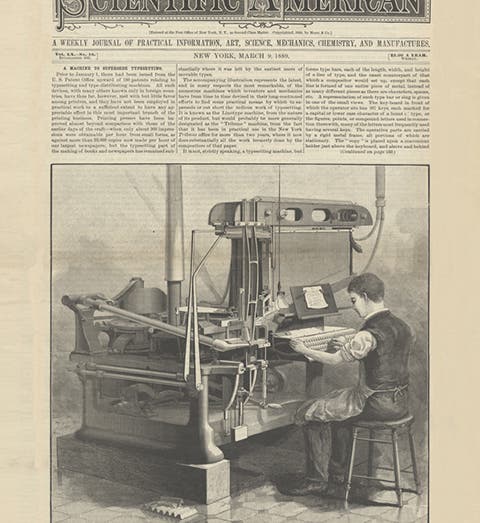Scientist of the Day - Ottmar Mergenthaler
Ottmar Mergenthaler, a German/American inventor, was born May 11, 1854. Mergenthaler invented one of the least heralded but most vital components of the modern information age: the Linotype machine. Around 1880, the composing room was the principal bottleneck in the printing industry. Every printed page had to be assembled by a composer from individual pieces of type, laid into a composing stick and justified by hand, and then, after printing, the forme had to be broken down and each individual piece of type returned to its appropriate bin in the letter cases. It was so labor intensive, and required such a reservoir of type, that it was almost impossible to print a newspaper with more than 8 pages, and even that was stretching it. Everyone felt the need for a more efficient way to set a page of type, hopefully dispensing with the composing room, but no one could come up with a workable mechanical compositor. Mergenthaler, who was a mechanical whiz and had trained as a watchmaker, and who was working at a tool shop in Baltimore, was asked by an entrepreneur in 1876 to have a go at building a mechanical typesetter. Ten years later, he had a successful Linotype machine.
Most of the key inventions that make up the Linotype seem to have come out of Mergenthaler's fertile and inventive mind, and they were all there, in his first machine, as it emerged in 1886. The operator selected a letter on a keyboard. When the key was pressed, a matrix – a slim mold for that particular letter about the size of half a stick of chewing gum – slid down a chute and into place on a little tray. Here is a matrix for the letter “S” (being held upside-down). The matrix for the next letter settled right next to it when its key was punched, and so on until the tray was full, and all the molds for the letters were in the proper order. Then the set of matrices moved a short distance to what was called the mold disk, where hot pot metal was injected and a cast made of the line of letters. When cooled, the slug, as it was called, dropped down into another tray, one full “line o' type”, ready to print. And then, perhaps the most ingenious part of Mergenthaler's invention, the matrices were mechanically separated, transported by conveyor up to the top of the machine, where they moved down the line, pushed by screw drives, and automatically fell into the correct bins for each letter, thanks to little coded notches at the top of each type matrix. Meanwhile, another line of type was being prepared, and another, and all one had to do was form them up and the page was ready to print. The slugs could then go back into the type-metal pot to be melted down and used again.
I have not yet found statistical figures that show how many type composers are needed to keep up with one linotype operator, but it wouldn't surprise me if the ratio were 50 to 1. Certainly a newspaper like the New York Tribune, which installed the first production Linotype machines in its newsroom in 1889, would have been able to print as many pages as it liked in a single night of press work with just a half-dozen Linotypes (eventually they had over 120!). Scientific American was impressed and put the Linotype on the front page of their Mar. 9, 1889 issue (first image). The Linotype was a fixture in every print shop except the very smallest right up until 1978, when offset lithography and phototypesetting made the Linotype as obsolete as the composing stick.
Mergenthaler became a wealthy man, but he was not unfortunately a healthy man; he came down with tuberculosis and died in 1899 at the age of 45. For many decades the company that produced his invention was called the Mergenthaler Linotype Company. We have a number of their publications in the Library, including a serial, the Linotype News, published from 1922 to 1966.
Most Linotype machines were scrapped in the late 1970s, but a few have hung around. Baltimore has always had a soft spot for Mergenthaler, since he was their adopted son, and there is a working Linotype in the Baltimore Museum of Industry (at the far end of the room, on the right). There is another in the Technical Museum in Vienna. Ottmar is buried in Loudon Park cemetery in Baltimore, and there is even a stained-glass window honoring the Linotype in Baltimore’s Zion Church. When the U.S. Postal Service in 1996 issued a commemorative series called "Pioneers of Communication,” Mergenthaler was one of the four chosen to be honored, at the upper right of the block of four (second image).
In 2012, a documentary film was made about Mergenthaler’s invention, called Linotype: The Film. I have not seen it, since the producers have managed to keep it off YouTube, but you can view a charming two-minute trailer here, where there are many gratifyingly clanky shots of a Linotype in action. It was a beautiful, functional piece of machinery.
Dr. William B. Ashworth, Jr., Consultant for the History of Science, Linda Hall Library and Associate Professor emeritus, Department of History, University of Missouri-Kansas City. Comments or corrections are welcome; please direct to ashworthw@umkc.edu.







